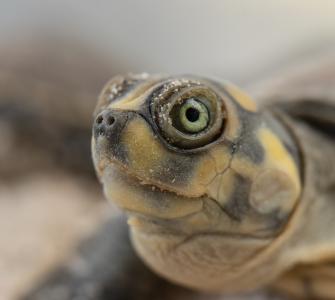Conservation of the taricaya (Podocnemis unifilis), also known as the yellow-spotted Amazon River Turtle, a freshwater turtle native to the Peruvian Amazon, faces significant challenges. Once a common species in the region's rivers and lakes, uncontrolled exploitation of its meat and eggs has led to a drastic decline in its population, especially in areas near cities and riverside communities (*Soini, 1999; FENAP, 2012).
Since 1979, the Pacaya Samiria National Reserve has implemented management programs aimed at recovering the taricaya for sustainable commercialization. The active participation of local communities in these programs has been crucial for the program’s success and responsible use of this resource has improved the communities’ quality of life.
The taricaya stands out as an ideal species for community management, thanks to its resistance to habitat changes and its ability to adapt quickly (**FENAP, 2012; ***Gagliardi, 2014). In recent years, there has been an increase in the presence of private zoo farms that operate under legal regulations and also export this resource. Unfortunately, due to the growing demand both nationally and internationally, this species continues to face threats, such as hunting for local consumption, and the illegal trade of eggs and body parts (used for handicrafts, as pets, etc.).
In partnership with Wildlife Conservation Society (WCS) Peru, Conservation Strategy Fund (CSF) evaluated the profitability of taricaya semi-captive farming if sustainably managed. This cost-benefit analysis (CBA) added key information needed to develop the most effective management strategies for the sustainable use or breeding of the taricaya under the implementation of management plans established by the Natural Protected Areas National Service of the State (SERNANP).
The CBA results demonstrate that the sustainable management of taricaya in the Pacaya Samiria National Reserve is not only economically viable, but would play a crucial role in the species’ conservation. The study identified eight management models and determined that a minimum scale of 14,410 hatchlings per year is required for financial viability, provided the addition of external, annual, short-term funding. However, to achieve a highly profitable commercialization model without external funding, at least 53,945 hatchlings per year are necessary. Enterprises with lower than 14,410 hatchlings would require long-term funding or subsidies ranging between S/18,848.45 and S/24,867.24 to reach economic viability. These results may vary depending on the management area and ecological conditions.
Through this research, CSF aims to determine the economic sustainability of taricaya management and identify the conditions that must be adopted to make it a profitable activity for local communities. Additionally, CSF recommends improving marketing strategies and expanding market access to further reinforce the financial viability of taricaya management initiatives. The results and recommendations from CSF’s study will empower communities to maximize the economic benefits of this activity while upholding responsible conservation practices.
__
This study was made possible with the generous support of the Wildlife Conservation Society (WCS) Peru.
__
Sources
- Image: Gino Tuesta, Shutterstock
- * Soini, P. (1999). Un Manual para el Manejo de Quelonios Acuáticos en la Amazonía Peruana (Charapa, taricaya, cupiso). Instituto de Investigaciones de la Amazonía Peruana. 83 p.
- ** FENAP. (Federación de la Nacionalidad Achuar del Perú). 2012. Comunidades indígenas organizadas para el manejo de tortugas acuáticas en cuencas del Huasaga y Huitoyacu, zona del Pastaza.
- *** Gagliardi, G. 2014. Informe científico para la elaboración del Dictamen de Extracción No Perjudicial para Taricaya (Podocnemis unifilis), especie incluida en el Apéndice II de la Convención sobre el Comercio Internacional de Flora y Fauna Silvestre Amenazadas (CITES). Instituto de Investigaciones de la Amazonía Peruana.

